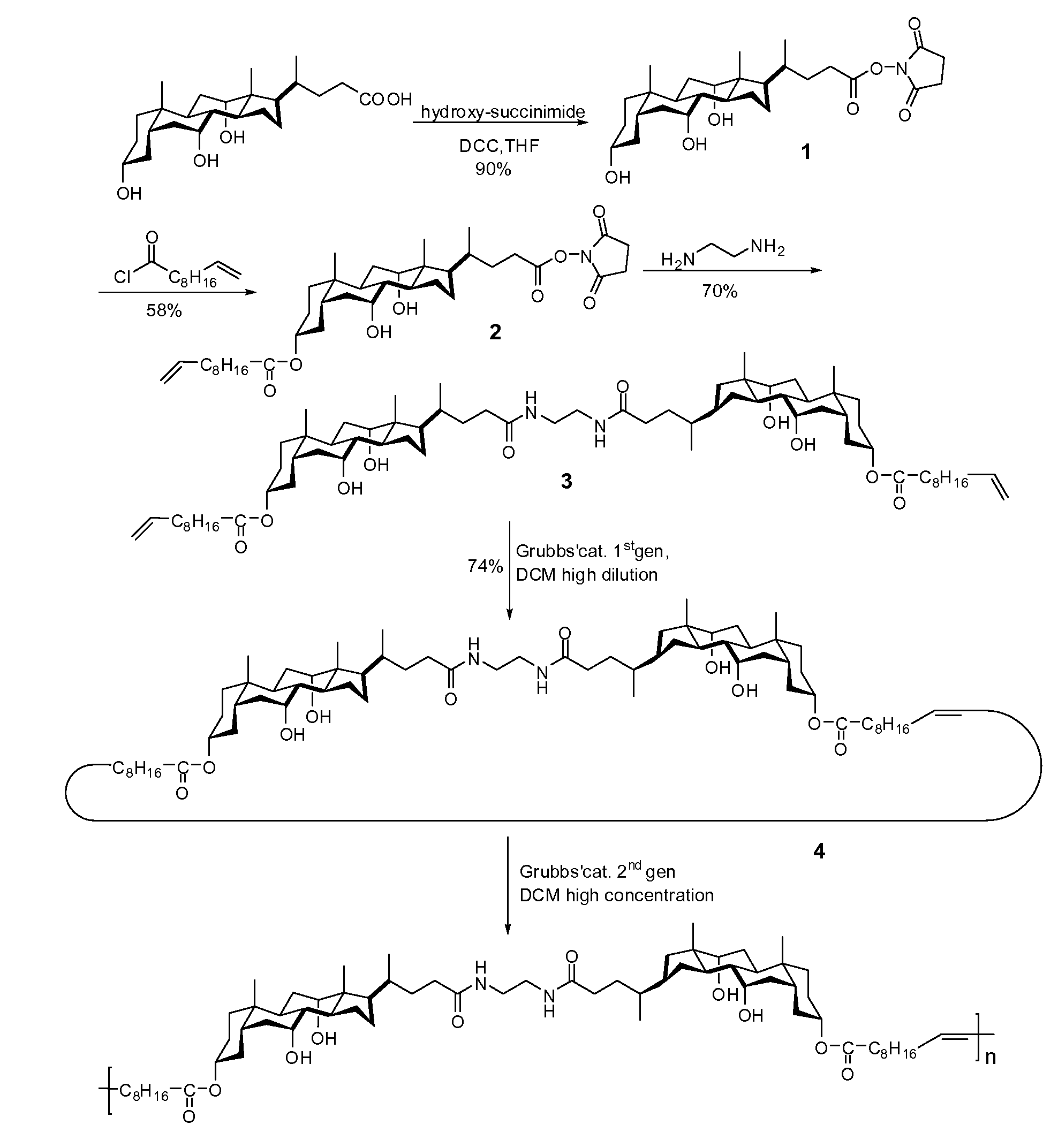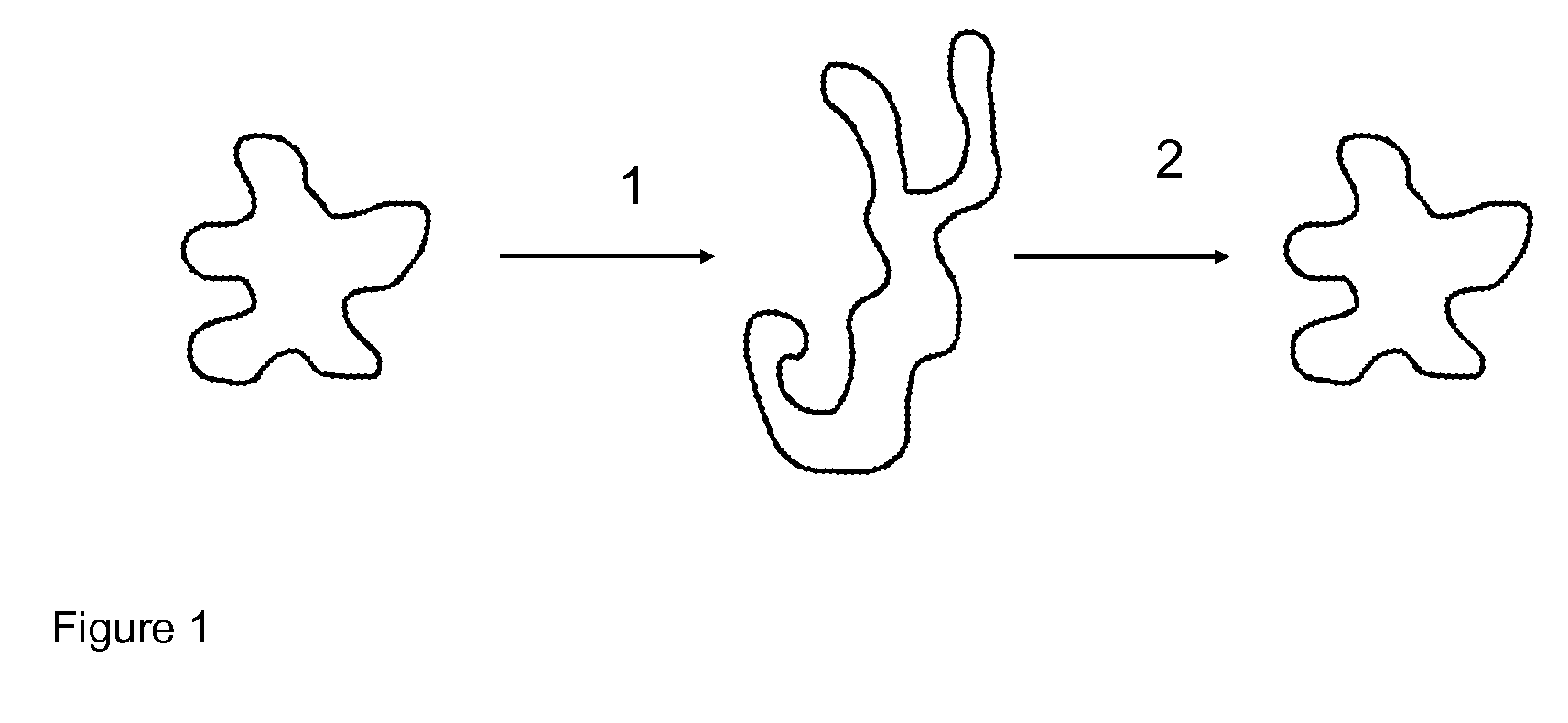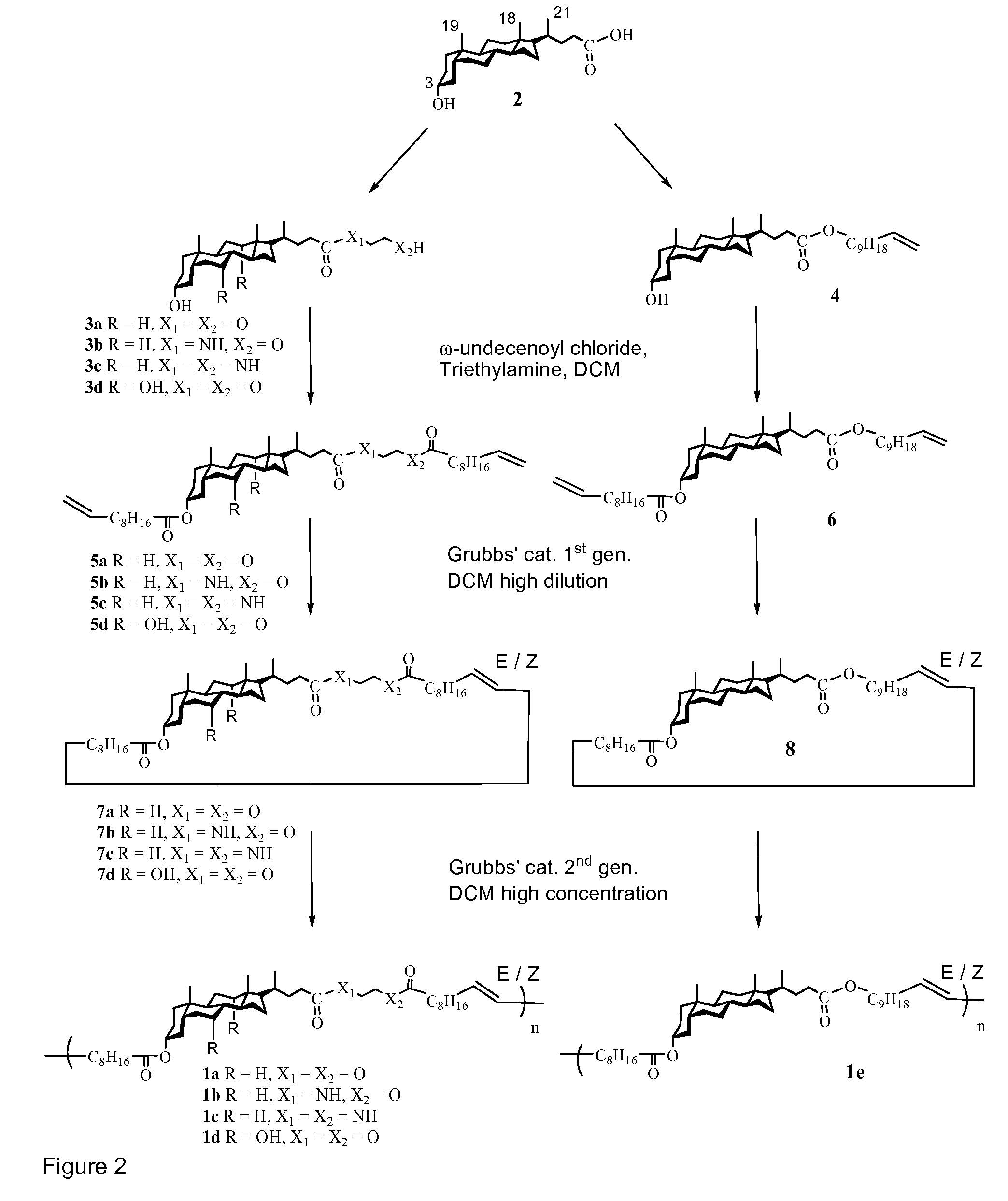Novel polymers, uses and methods of manufacture thereof
a polymer and polymer technology, applied in the field of new polymers, can solve the problems of necrosis or abnormal regeneration, large stress mismatch at the interface, and insufficient mechanical properties of tissue engineering,
- Summary
- Abstract
- Description
- Claims
- Application Information
AI Technical Summary
Benefits of technology
Problems solved by technology
Method used
Image
Examples
example 1
[0166]Specific embodiments of polymers of the invention were prepared according to the reaction scheme shown in FIG. 2 and tested as follows.
[0167]More specifically, novel polymers were synthesized by ring-closure metathesis (RCM) of two flexible chains attached to a bile acid core through ester bonds, and their entropy-driven ring-opening metathesis polymerization (ED-ROMP) using ruthenium-based Grubbs catalysts. The polymers obtained show typical rubberlike elasticity, with elongation moduli that favorably compare to those of soft tissues and elastin [Park et al., Biomaterials: An Introduction, 2nd ed., Plenum, N.Y., 1992; Gosline et al., Philos. Trans R Soc. London 2002, 357, 121-132.] (see FIG. 3) and constitute, to the best of the inventor's knowledge, the first example of degradable thermoplastic amorphous elastomers.
[0168]Reagents
[0169]Lithocholic acid, ω-undecylenyl alcohol and ω-undecenoyl chloride were purchased from Aldrich, Grubbs' catalysts (1st and 2nd generations) fro...
example 2
[0196]Shape memory polymers 1a, 1b, 1c, 1d and 1e were synthesized according to the reaction scheme shown in FIG. 2.
[0197]These polymers had the following characteristics.
TABLE 2Weight average molecular weight (Mw), glass transitiontemperature (Tg) and Young's modulus (E) of polymers1a, 1b, 1c, 1d and 1ePolymerMw × 103Tg DMA (° C.)E at 37.5° C. (Mpa)1a45212.4 ± 0.41.23 ± 0.061b39749.3 ± 1.1269 ± 97 1c400.563.2 ± 2.0590 ± 98 1d319.248.2 ± 0.7406 ± 88 1e27819.9 ± 0.62.09 ± 0.32
TABLE 3Rr and Rf values measured for 3 shape memory cycles in warmdrawing mode.PolymerRr (1)Rr (2)Rr (3)Rf (1)Rf (2)Rf (3)1a98.8 ± 0.299.7 ± 0.4 99.9 ± 0.0398.4 ± 0.198.2 ± 0.198.3 ± 0.31b97.4 ± 1.098.9 ± 0.799.5 ± 0.298.1 ± 0.298.1 ± 0.298.0 ± 0.21c95.3 ± 2.496.2 ± 2.395.9 ± 1.895.7 ± 0.795.6 ± 0.595.9 ± 1.41d95.4 ± 1.998.7 ± 0.799.5 ± 0.294.6 ± 2.094.2 ± 1.893.6 ± 2.01e97.8 ± 0.699.1 ± 0.599.8 ± 0.497.9 ± 0.197.9 ± 0.297.9 ± 0.2
TABLE 4Rr and Rf values measured for 3 shape memory cycles in colddrawing mode.Poly...
example 3
[0198]Shape memory polymers 10b, 10c, and 10d were synthesized according to the reaction scheme shown in FIG. 10, wherein molar ratios n and m are 0.81 and 0.19; 0.63 and 0.37; and 0.84 and 0.16 for polymers 10b, 10c and 10d, respectively.
[0199]These polymers had the following characteristics.
TABLE 5Weight average molecular weight (Mw), glass transitiontemperature (Tg) and Young's modulus (E) of polymers1a, 1b, 1c, 1d and 1e.PolymerMw × 103Tg DMA (° C.)E at 37.5° C. (Mpa)10b41434.4 ± 0.45.83 ± 1.0210c404.341.5 ± 4.975.4 ± 29.710d27034.2 ± 0.819.6 ± 4.2
TABLE 6Rr and Rf values measured for 3 shape memory cycles in warmdrawing mode.Poly-merRr (1)Rr (2)Rr (3)Rf (1)Rf (2)Rf (3)10b97.1 ±99.5 ±99.4 ± 0.494.9 ± 1.194.4 ± 1.694.7 ± 1.21.40.210c89.7 ±94.6 ±97.1 ± 0.392.1 ± 1.690.7 ± 1.890.1 ± 2.01.40.410d96.5 ±99.0 ±99.6 ± 0.191.8 ± 3.591.4 ± 2.090.7 ± 2.43.50.7
TABLE 7Rr and Rf values measured for 3 shape memory cycles in colddrawing mode.Poly-merRr (1)Rr (2)Rr (3)Rf (1)Rf (2)Rf (3)10b93.5 ±...
PUM
| Property | Measurement | Unit |
|---|---|---|
| Tg | aaaaa | aaaaa |
| Tg | aaaaa | aaaaa |
| Tg | aaaaa | aaaaa |
Abstract
Description
Claims
Application Information
 Login to View More
Login to View More - R&D
- Intellectual Property
- Life Sciences
- Materials
- Tech Scout
- Unparalleled Data Quality
- Higher Quality Content
- 60% Fewer Hallucinations
Browse by: Latest US Patents, China's latest patents, Technical Efficacy Thesaurus, Application Domain, Technology Topic, Popular Technical Reports.
© 2025 PatSnap. All rights reserved.Legal|Privacy policy|Modern Slavery Act Transparency Statement|Sitemap|About US| Contact US: help@patsnap.com



